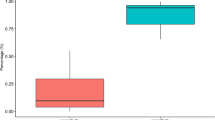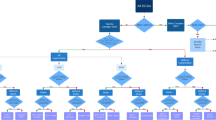Abstract
This study aimed to evaluate the diagnosis of pediatric left ventricular hypertrophy (LVH) and right ventricular hypertrophy (RVH) by the Glasgow electrocardiogram (ECG) interpretation program compared to interpretations provided by two pediatric cardiologists. ECGs had all identifying information removed and were sent to the cardiologists independently with the patient’s age and sex and the clinical indication for the ECG, if known. A total of 984 ECGs were included in the study, of which 664 were reported “with clinical indication” and 320 were reported “blind.” With respect to an averaged diagnosis of the two cardiologists, the sensitivity of the program for RVH was better when the cardiologists reported blind (73.3%) than with the clinical indication (53.5%), with the same trend for the program compared with individual cardiologists. The specificity of the program was at least 94.4% in all cases. For LVH, the program had high specificity (=95.8%) for “reported blind” and “with clinical indication” cases but low sensitivities throughout (the highest was 44.4% with respect to an averaged diagnosis of the two cardiologists reporting with the clinical indication). Subsequent discussion revealed that if the cardiologists had disagreed with one another initially, their consensus opinion was twice as likely to be in agreement with the program.

Similar content being viewed by others
References
DG Altman (1991) Practical Statistics for Medical Research Chapman & Hall/CRC Press Boca Raton, FL 259
RB Devereux PN Casale RR Eisenberg DH Miller P Kligfield (1984) ArticleTitleElectrocardiographic detection of LVH using echocardiographic determination of left ventricular mass as the reference standard J Am Coll Cardiol 3 82–87 Occurrence Handle6228571 Occurrence Handle1:STN:280:DyaL2c%2FovVKmsQ%3D%3D Occurrence Handle10.1016/S0735-1097(84)80433-7
B Guller T Jones J McCloskey SP Herndon (1990) ArticleTitleThe Hewlett-Packard pediatric EGG computer program (HP-P3) and independent clinical information [Abstract] J Electrocardiol 23 IssueIDsuppl 204 Occurrence Handle2090745
R Hatala GR Norman LR Brooks (1999) ArticleTitleImpact of a clinical scenario on accuracy of electrocardiogram interpretation J Gen Internal Med 14 126–129 Occurrence Handle1:STN:280:DyaK1M7ntVCrtQ%3D%3D Occurrence Handle10.1046/j.1525-1497.1999.00298.x
D Levy SB Labib KM Anderson et al. (1990) ArticleTitleDeterminants of sensitivity and specificity of electrocardiographic criteria for left ventricular hypertrophy Circulation 81 815–820 Occurrence Handle2137733 Occurrence Handle1:STN:280:DyaK3c7msl2qsQ%3D%3D
PW Macfarlane EN Coleman B Devine et al. (1990) ArticleTitleA new 12-lead pediatric ECG interpretation program J Electrocardiol 23 IssueIDsuppl 76–81 Occurrence Handle2151043
PW Macfarlane EN Coleman EO Pomphrey et al. (1990) ArticleTitleNormal limits of the high-fidelity pediatric ECG J Electrocardiol 22 IssueIDsuppl 162–168
PW Macfarlane B Devine S Latif et al. (1990) ArticleTitleMethodology of ECG interpretation in the Glasgow program Meth Inform Med 29 354–355 Occurrence Handle2233383 Occurrence Handle1:STN:280:DyaK3M%2FktF2nsw%3D%3D
Macfarlane, PW, Lawrie, TV (eds) (1989) Comprehensive Electrocardiology, Pergamon, Oxford, UK, pp 415
PR Rijnbeek M Witsenburg A Szatmari J Hess JA Kors (2001) ArticleTitlePEDMEANS: a computer program for the interpretation of pediatric electrocardiograms J Electrocardiol 34 IssueIDsuppl 85–91 Occurrence Handle11781941
K Sekiguchi T Kanda M Osada et al. (1999) ArticleTitleComparative accuracy of automated computer analysis versus physicians in training in the interpretation of electrocardiograms J Med 30 75–81 Occurrence Handle10515243 Occurrence Handle1:STN:280:DyaK1MvktlaltA%3D%3D
JL Willems C Abreu-Lima P Arnaud et al. (1987) ArticleTitleTesting the performance of ECG computer programs: the CSE diagnostic pilot study J Electrocardiol 20 IssueIDsuppl 73–77 Occurrence Handle3694105
Acknowledgments
We are grateful to the staff of the cardiology department at the Royal Hospital for Sick Children for assistance with this study.
Author information
Authors and Affiliations
Corresponding author
Rights and permissions
About this article
Cite this article
Hamilton, R., Houston, A., McLeod, K. et al. Evaluation of Pediatric Electrocardiogram Diagnosis of Ventricular Hypertrophy by Computer Program Compared with Cardiologists. Pediatr Cardiol 26, 373–378 (2005). https://doi.org/10.1007/s00246-004-0748-8
Published:
Issue Date:
DOI: https://doi.org/10.1007/s00246-004-0748-8




